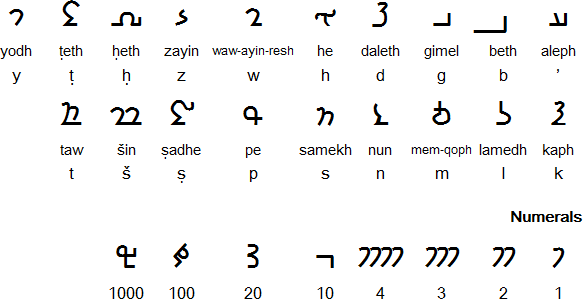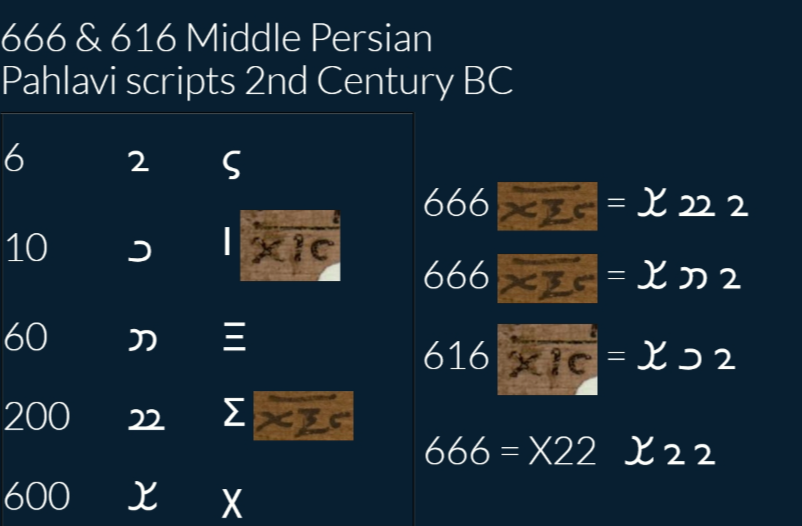W = 6 WAW-AYIN-RESH
666 & 616 Middle Persian
Pahlavi scripts 2nd Century BC

Source: http://www.fontspace.com/unicode/block/Inscriptional+Pahlavi
6 |
𐭥 |
ς |
10 |
𐭩 |
Ι
|
60 |
𐭮 |
Ξ |
200 |
𐭱 |
Σ
|
600 |
𐭔 |
χ |
666  = 𐭥 𐭱 𐭔
= 𐭥 𐭱 𐭔
666  = 𐭥 𐭮 𐭔
= 𐭥 𐭮 𐭔
616  = 𐭥 𐭩 𐭔
= 𐭥 𐭩 𐭔
666 = X22 |
𐭔 |
𐭥 |
𐭥 |
666 & 616 Middle Persian
Pahlavi scripts 2nd Century BC

Source: http://www.fontspace.com/unicode/block/Inscriptional+Pahlavi
|
666
|
666 = WWW |
𐭥 |
𐭥 |
𐭥 |
666 = X22 |
𐭔 |
𐭥 |
𐭥 |

I am Aleph, א, and Tav, ת, the beginning and the end.
The Aleph, א, is the first character in the Hebrew alphabet and represents God, the One, the First, and the beginning.
The Tav, ת, is the last character in the Hebrew alphabet and represents a sacred enclosure or place, the most important of which is the Holy of Holies or the temple, which represent the presence of the Lord.
|
gematria |
English |
Greek |
Egyptian |
Phoenician |
Phoenician |
Gothic |
Gothic |
Hebrew | Hebrew Sound |
God |
Imperial |
||||||||||||||||
|---|---|---|---|---|---|---|---|---|---|---|---|---|---|---|---|---|---|---|---|---|---|---|---|---|---|---|---|
| 1 | A Aleph |
𐭠 |
Αα Alpha |
𓃾 |
𐤀 |
ALF |
𐌰 |
AHSA Ansuz |
א |
Alef |  Al·lah |
𐡀 |
|||||||||||||||
| 2 | B Beth |
𐭡 |
Ββ Beta |
𓉐 |
𐤁 |
BET |
𐌱 |
BAIRKAN Berkanan |
ב |
Bet |
𐡁 |
||||||||||||||||
| 3 | C Zayin Gimel |
𐭢 |
Γγ Gamma |
𓌙 |
𐤂 |
GAML |
𐌲 |
GIBA Gebō |
ג |
Gimel | Guþ Guth Goth God God·Wau God·Vav Christ godless - gudalaus (adj. A) |
𐡂 |
|||||||||||||||
| 4 | D Daleth |
𐭣 |
Δδ Delta |
𓉿 |
𐤃 |
DELT |
𐌳 |
DAGS Dagaz |
ד |
Dalet |
𐡃 |
||||||||||||||||
| 5 | E He |
𐭤 |
Εε Epsilon |
𓀠 |
𐤄 |
HE |
𐌴 |
AIHVUS Eihwaz, |
ה |
He |
𐡄 |
||||||||||||||||
| 6 | F WAW-AYIN-RESH |
𐭥 |
Σσς Sigma |
𓌉 |
𐤅 |
WAU |
𐌵 |
QAIRTHRA |
ו |
Vav |  yod·Wau yod·Fah Fre·yr Lord – frauja (m. N) Master (n.) - frauja (m. N) |
𐡅 |
|||||||||||||||
| 7 | G Gimel Zayin |
𐭦 |
Ζζ Zeta |
𓎛 |
𐤆 |
ZAI |
𐌶 |
IUJA algiZ |
ז |
Zayin | Guþ Guth Goth God God·Wau God·Vav Christ godless - gudalaus (adj. A) |
𐡆 |
|||||||||||||||
| 8 | H heth |
𐭧 |
Ηη Eta |
𓉗 |
𐤇 |
HET |
𐌷 |
HAGL Haglaz |
ח |
Chet |
𐡇 |
||||||||||||||||
| 9 | I teth yodh |
𐭨 |
Θθ Theta |
𓄤 |
𐤈 |
TET |
𐌸 |
THIUTH |
ט |
Tet |  Theos·weh I·weh Theos·veh I·veh Jesus - Iesus (m. A) |
𐡈 |
|||||||||||||||
| 10 | J yodh teth |
𐭩 |
Ιι Iota |
𓂝 |
𐤉 |
YOD |
𐌹 |
EIS |
י |
Yod |  Yod·weh J·weh Yod·veh J·veh Jesus - Iesus (m. A) |
𐡉 |
|||||||||||||||
| 20 | K kaph |
𐭪 |
Κκ Kappa |
𓂧 |
𐤊 |
KAF |
𐌺 |
KUSMA Kaunan |
כ
|
Kaf |
𐡊 |
||||||||||||||||
| 30 | L lamedh |
𐭫 |
Λλ Lambda |
𓋿 |
𐤋 |
LAMD |
𐌻 |
LAGUS Laguz |
ל |
Lamed |
𐡋 |
||||||||||||||||
| 40 | M mem-qoph |
𐭬 |
Μμ Mu |
𓈖 |
𐤌 |
MEM |
𐌼 |
MANNA Mannaz |
מ
|
Mem Water |
𐡌 |
||||||||||||||||
| 50 | N nun |
𐭭 |
Νν Nu |
𓆓 |
𐤍 |
NUN |
𐌽 |
NAUTHS Naudiz |
נ
|
Nun |
𐡍 |
||||||||||||||||
| 60 |
Samekhi س |
𐭮 |
Ξξ Xi |
𓊽 |
𐤎 |
SEMK |
𐌾 |
JER |
ס |
Samekh |  J·weh J·veh |
𐡎 |
|||||||||||||||
| 70 | O ayin |
Οο Omicron |
𓁹 |
𐤏 |
AIN |
𐌿 |
URUS ūruz |
ע |
Ayin |
𐡏 |
|||||||||||||||||
| 80 | P pe |
𐭯 |
Ππ Pi |
𓂋 |
𐤐 |
PE |
𐍀 |
Perþō |
פ
|
Pe |
𐡐 |
||||||||||||||||
| 90 | Q Qōp |
𐭰 |
Ϙ Koppa Ϟ ϟ |
𓎤 |
𐤑 𐤒 |
QOF qoph |
𐍁 |
tsade Tsadi צ |
ק
|
Qof Tsadi Ṣādhē |
𐡑
|
||||||||||||||||
| 100 | R | Ρρ Rho |
𓁶 |
𐤓 |
ROSH |
𐍂 |
Raidō |
ר |
Resh |
𐡓 |
|||||||||||||||||
| 200 | S shin |
𐭱 |
Σσς Sigma |
𓐮 |
𐤔 |
SHIN |
𐍃 |
ש |
Shin |  |
𐡔 |
||||||||||||||||
| 300 | T taw |
𐭲 |
Ττ Tau |
𓏴 |
𓏴 |
TAU |
𐍄 |
Tīwaz |
ת |
Tav |
𐡕 |
||||||||||||||||
| 400 | U | 𐭓 𐭔 𐭕 | Υυ Upsilon |
𐍅 |
wunjō |
|
Yah·Weh 𐍅𐌴𐌹𐌷𐌰𐌽 • (weihān) to hallow, consecrate, sanctify Christ |
||||||||||||||||||||
| 500 | V | 𐭓 𐭔 𐭕 | Φφ Phi |
𐍆 |
fehu FAIHU |
|
yah·Veh yah·Feh |
||||||||||||||||||||
| 600 | W | 𐭓 𐭔 𐭕 | Χχ Chi |
𐍇 |
ingwaz IGGWS xʷ WunJô |
ם |
Water Mem (final) |
 Yŋɡ·we Ing·wi Christ - Xristus (m. U) christmas - weiha 𐍅𐌴𐌹𐌷𐌰𐌽 • (weihān) to hallow, consecrate, sanctify Christ |
|||||||||||||||||||
| 700 | X Xi Psi |
𐭓 𐭔 𐭕 | Ψψ Psi |
𐍈 |
HWAIR
ƕ xʷWynn |
|
 ƕ·weh Yah·ƕ cauldron Christ - Xristus (m. U) |
||||||||||||||||||||
| 800 | Y | 𐭓 𐭔 𐭕 | Ωω Omega |
𐍉 |
ōþala OTHAL |
|
Yah·weh Yah·veh Yng·vi 𐍅𐌴𐌹𐌷𐌰𐌽 • (weihān) to hallow, consecrate, sanctify Christ |
||||||||||||||||||||
| 900 | Z | 𐭓 𐭔 𐭕 |
ϡ Sampi |
𐍊 |
|
Zeus |
W ⟨wh⟩ is used in English to represent Proto-Germanic /hw
X ⟨xi⟩ is used in English for /kʃ/ in words such as flexion. (It is equivalent to ⟨c⟩ plus the digraph ⟨ti⟩, as in action.)
𐤅 (w) The sixth letter of the Phoenician abjad, called waw.
- Ancient Greek: Ϝ (W), Υ (U)
- Gothic: 𐍅, 𐌵 /kʷ/
- Old Italic: 𐌅, 𐌖
- Latin: F, Y, U, V, W
- Aramaic: 𐡅
Gothic 9 𐌸 Uncertain; has been related to Ancient Greek Θ (Th, “theta”), Ψ (Ps, “psi”) and Φ (Ph, “phi”).
In Ancient Greek, Χ chi and Ψ psi were among several variants of the same letter,used originally for kʰ and later as ΧΣ for ks Christ ( ΧΣ and ΧC ).
Xi 700 is not to be confused with the letter Χχ chi 600, which gave its form to the Latin/English letter X 700. While having no Latin derivative, the Xi was adopted into the early Cyrillic alphabet 𐌎 , as the letter ksi (Ѯ, ѯ).
Old Norse Yng·vi ˈYŋɡ·we, Old High German Ing·wi and Old English Ing·ƿine are names that relate to a theon·ym which appears to have been the older name for the god Fre·yr.
Samekh the Phoenician letter gave rise to the Greek xi Ξ whereas its name may also be reflected in the name of the otherwise unrelated Greek letter sigma.
The archaic "grid" shape of Western Greek xi was adopted in the early Etruscan alphabet 𐌎 , but was never included in the Latin alphabet.
Waw/Vav 6 It is the origin of Greek Ϝ (digamma ϛ)  and Υ (upsilon), Cyrillic У, Latin F and U and later Y, and the derived Latin-alphabet letters V, and W.
and Υ (upsilon), Cyrillic У, Latin F and U and later Y, and the derived Latin-alphabet letters V, and W.
Waw/Vav 6 the letter likely originated with an Egyptian hieroglyph 𓌉
| Stigma The name "stigma" (στίγμα) was originally a common Greek noun meaning "a mark, dot, puncture" or generally "a sign", from the verb στίζω ("to puncture"). Stigma (ϛ) is a ligature of the Greek letters sigma (Σ) and tau (Τ), στ |
Sigma Σ, σ, ς Ϲ ϲ The shape (Σς) and alphabetic position of sigma is derived from the Phoenician letter W (shin) Latin S Greek Σσς Gothic Sowilo / Sigel ᛋ.
.jpg)
